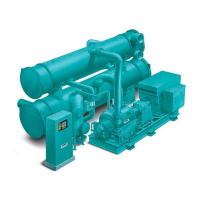JOHNSON CONTROLS
31
FORM 155.17-N1
ISSUE DATE: 4/1/2013
9
SECTION 9 – HIGH-TEMPERATURE GENERATOR INLET STEAM PIPING
The YORK ParaFlow
TM
absorption chiller is nomi-
nally rated for dry steam with minimal superheat, and
a pres sure of 115 PSIG (7.93 bar) at the steam valve.
The in let steam must not have a temperature higher
than 363°F (183.9°C) and can not have a saturation
pressure high er than 128 PSIG (8.83 bar). The con-
densate leaves the drain cooler at approximately 15.0
PSIG (2.0 bar) at 180°F (82.2°C).
PRESSURE
Since a lower steam saturation pressure cor re sponds
to a lower temperature in the generator, a ParaFlow
TM
chiller’s available capacity varies with the steam pres-
sure at the steam valve. Therefore, it is im por tant
when designing and fabricating the steam inlet pip ing
to keep the pressure drop to a minimum. This is espe-
cially important between the steam control valve and
the generator inlet head.
FLOW
Steam flow is equally important as steam pres sure.
Flow is usually measured in pounds per hour (Lbs/
Hr.) and refers to the amount of steam being consumed
by the unit. To control the steam flow through the
chill er, Johnson Controls factory supplies a flow set-
ting needle valve on the steam condensate return line.
PIPING
All steam field piping should be installed in accor-
dance with any local, state or federal codes that may
apply. Piping should be adequately supported and
braced independent of the chiller. The support system
must ac count for the expansion and contraction of
the steam pip ing, avoiding the imposition of strain on
chiller com po nents. Steam piping should be designed
in ac cor dance with good engineering practice.
A typical steam piping schematic is shown on the
next page. Both steam supply and condensate pipes
must be prop er ly sized and pitched toward intel-
to prevent liquid ham mer ing. Steam mains should
be sized in ac cor dance with the re quired steam flow
and acceptable pressure drop. Wher ev er pos si ble, the
steam supply line to the ab sorp tion unit should be tak-
en off the main steam sup ply line from the top side to
minimize the possibility of con den sate carry-over. Ad-
di tion al consideration should be giv en to steam flow
ve loc i ty, especially in those ap pli ca tions where noise
is a factor. Generally speaking, steam ve loc i ties up to
6,000 fpm (30 m/s) will not pro duce an objectionable
noise lev el. Always pitch the steam sup ply line to pre-
vent steam or water ham mer ing.
The factory supplied steam control valve must be in-
stalled as close as possible to the high-temperature
generator steam in let flange in order to minimize the
pressure drop from the valve exit to the generator inlet.
INLET STEAM PIPING COMPONENTS
The following is a description of each major compo-
nent on the steam entering side of the steam piping.
Refer to the steam piping schematic (Figure 12 on
page 33) for the actual recommended com po nent
location.
MANUAL BLOCK VALVE
This valve is installed to man u al ly shut off the steam
supply to the unit, thus allowing ease of service if re-
quired.
AUTOMATIC SHUT-OFF VALVE
This failsafe valve must be sup plied by others. The
valve must spring closed to shut 100% of the steam
flow off, and be bub ble tight. It’s purpose is to pro-
tect the ab sorp tion unit from crystallization in the case
of a cycling/safety shut down or a power fail ure. The
Johnson Controls supplied steam control valve will
re main in whatever position it happened to be in at
the time of a power failure, letting steam flow into the
unit. There fore, a valve that will com plete ly shut-off
steam flow to the unit dur ing such a fail ure is required
to keep the unit from crys tal li za tion.
The automatic shut-off valve should not be a butter-
fly-type valve or any other quick opening type valve.
Fur ther more, it must be installed as close as possible
to the Johnson Controls-sup plied Steam Control valve
without elim i nat ing any of the re quired components
between the two valves. If these requirements are
not adhered to, during long unit shut downs the steam
caught between the two valves would condensate.
Upon unit start-up, a surge of steam coming from the
automatic shut-off valve could pick up the con den sate
and slam it up against the control valve, (water ham-
mer) causing damage. In some situations, due to pip-
ing arrangements, it may not be possible to locate the
automatic shut-off valve close enough to the control
valve as specified. In these situations, it is permissible
to locate the automatic shut-off valve downstream of
the control valve.

